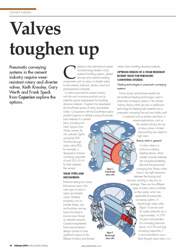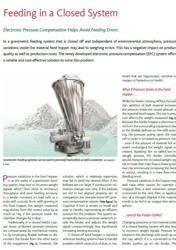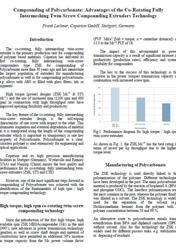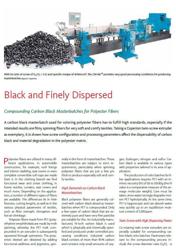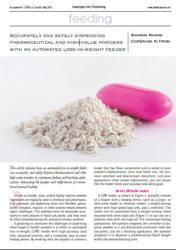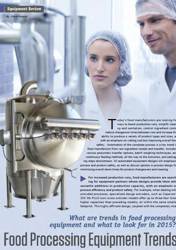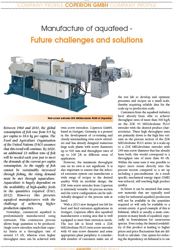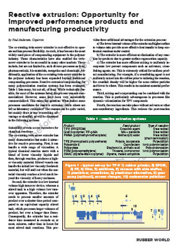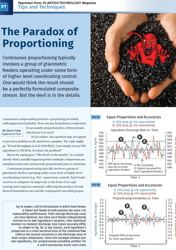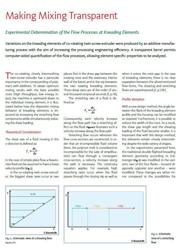Pneumatic conveying systems in the cement industry require wear-resistant rotary and diverter valves.
Publications
Showing all publications
-
Valves Toughen Up
Solids and Bulk Handling
-
Feeding in a Closed System
Kunststoffe International, 1-2/2016
In a gravimetric feeding system that is closed off and independent of environmental atmosphere, pressure variations inside the material feed hopper may lead to weighing errors. This has a negative impact on product quality as well as production costs. The newly developed electronic pressure compensation (EPC) system offers a reliable and cost-effective solution to solve this problem.
-
Compounding of Polycarbonate: Advantages of the Co-Rotating Fully Intermeshing Twin Screw Compounding Extruders Technology
Plastics Technology Magazine, 6/2015
The co-rotating, fully intermeshing twin-screw extruder is the primary production unit for compounding of polymer based materials. Coperion has delivered its first co-rotating, fully intermeshing twin-screw compounders type ZSK for compounding of Polycarbonate more than 30 years ago and has meanwhile the largest population of extruders for manufacturing polycarbonate as well as for compounding polycarbonate, e.g. alloys with ABS or filled with glass fibers, talc or pigments.
-
Black and Finely Dispersed - Compounding Carbon Black Masterbatches for Polyester Fibers
Kunststoffe International, 6-7/2015
A carbon black masterbatch used for coloring polyester fibers has to fulfill high standards, especially if the intended results are filmy spinning fibers for very soft and comfy textiles. Taking a Coperion twin-screw extruder as exemplary, it is shown how screw configuration and processing parameters affect the dispersability of carbon black and material degradation in the polyester matrix.
-
Accurately and safely dispensing pharmaceutical and high-value powders with an automated loss-in-weight feeder
Tablets & Capsules
This article explains how an automated loss-in-weight feeder can accurately and safely dispense pharmaceutical and other high-value powders in continuous feeding and batching applications, eliminating the dangers and inefficiencies of conventional manual loading.
-
Food Processing Equipment Trends
Western Food Processor
Today’s food manufacturers are looking for ways to boost production runs, simplify cleanup and sanitation, control ingredient costs, reduce changeover times between runs and increase the ability to produce a variety of product types and sizes, all with an emphasis on cutting cost but improving overall food safety. Automation of the complete process is a key trend in food manufacture from raw ingredient receipt and transfer, including various pneumatic transfer options, batch weighing techniques, and continuous feeding methods, all the way to the extrusion, and packaging steps downstream.
-
Manufacture of aquafeed - Future challenges and solutions
International Aquafeed Directory 2014/2015
Nowadays, commercial aquafeed is predominantly manufactured using extrusion. This continuous process allows huge quantities to be produced. Single screw extruders reach their capacity limits at a throughput rate of around 15 t/h, whereas even higher throughput rates can be achieved with twin screw extruders. Coperion GmbH, based in Stuttgart, Germany, is a pioneer in the development of co-rotating and closely intermeshing twin screw extruders and has already designed numerous large scale plants with screw diameters up to 420 mm and throughput rates of up to 100 t/h in different areas of application.
-
Reactive extrusion: Opportunity for improved performance products and manufacturing productivity
Rubber World
The co-rotating twin-screw extruder is cost-effective to operate and has process flexibility. As such, it has become most widely used piece of compounding equipment in the polymer industry. These characteristics have also enabled the twin-screw extruder to be successful in many other markets. These include, but are not limited to, such diverse processes as food, pharmaceuticals, bio-materials, energetics and chemicals.
-
The Paradox of Proportioning
Plastics Technology Magazine, 10/2015
Continuous proportioning typically involves a group of gravimetric feeders operating under some form of higher level coordinating control. One would think the result should be a perfectly formulated composite stream. But the devil is in the details.
-
Making Mixing Transparent
Kunststoffe International, 7/2014
Variations on the kneading elements of co-rotating twin-screw extruder were produced by an additive manufacturing process with the aim of increasing the processing engineering efficiency. A transparent barrel permits computer-aided quantification of the flow processes, allowing element-specific properties to be analyzed.
